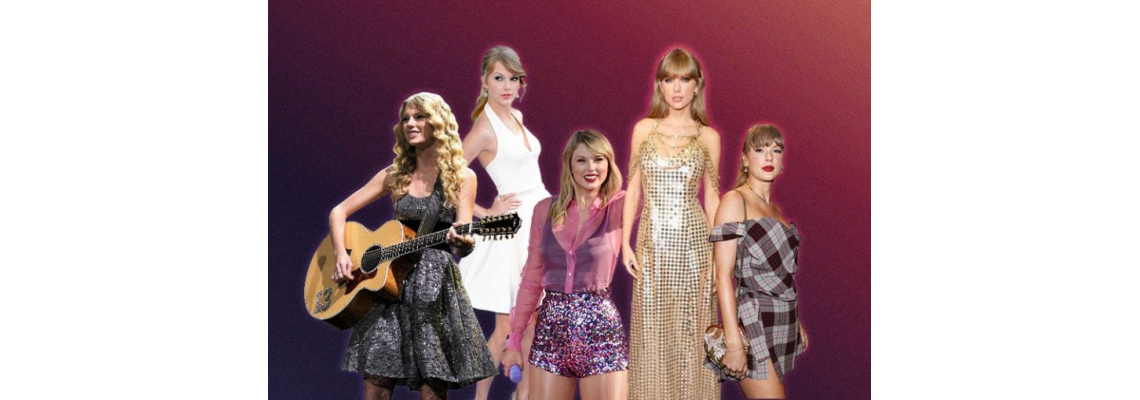Taylor Swift outfits guide iconic looks from each Eras album and tour

Taylor Swift outfits
Reading Taylor Swift’s Wardrobe, Era by Era
Taylor Swift’s outfits do more than “match the
music.” They carry the plot. A color shows up, a hemline changes, a fabric
catches the light differently—and suddenly you understand where the
story is headed. That’s why fans clock the clothes as closely as the set list.
The looks aren’t add-ons; they’re part of the language.
Why the clothes land the way they do
Pop wardrobes have jobs: translate sound into
image, help a stadium read emotion at a distance, and give fans a shorthand they
can copy without designer budgets. Swift’s teams keep the vocabulary small and
legible—two or three silhouettes, a disciplined palette, a few repeating
motifs—so an era reads in half a second. It’s graphic design, just on a body.
Debut (2006)
Sundresses and boots, curls left mostly alone.
Country-pop sincerity. A young songwriter framed as approachable, not
untouchable. The garments were practical for small stages and radio stops, and
that practicality did half the branding.
Fearless (2008)
Fringe and sparkles—movement pieces. Onstage,
the fabric did the work: hair flips and guitar swings became light shows.
Optimism made visible. This is where “arena scale” starts to feel natural.
Speak Now (2010)
Full skirts, purples, fairytale undertones.
Not ironic—earnest theater. The volume matched the songs’ big arcs, and the
gowns carried ballads as surely as the lighting rigs did.
Red (2012)
Stripes, high-waisted shorts, flats, a
declarative red lip. Graphics you could draw from memory. It was a pop crossover, and it looked like it: clean lines, merch-friendly iconography, easy for fans
to remix at home.
1989 (2014)
Tailored coordinates, metallics, gloss.
Choreography-ready. The camera loved the clean edges; so did late-night TV.
Even the color blocking felt percussive, in step with the new synth-pop polish.
Reputation (2017)
Black layers, snake motifs, shine with bite.
Narrative control turned into costume: lean into the villain framing and own
it. High contrast, designed to be read fast under strobe and pyro.
Lover (2019)
Pastels, hearts, iridescence. A pressure
release after Reputation. The palette
lifted the mood without shrinking the stage picture. Joy, but engineered for
scale.
Folklore / Evermore (2020)
Cardigans, checks, long coats, earth tones.
Textures for close-up. Lockdown records asked for interiority; the clothes
answered with knit and wool instead of shimmer. The cardigan worked because it
felt like an artifact from the album’s world, not a logo stamped on cotton.
Midnights (2022)
Navy and amethyst sparkles, celestial cues,
occasional faux-fur. Disco after dark. Glitter, but with a nocturne
palette—less glare, more gleam. Stadium lights turned sequins into moving
constellations.
What’s going on under the hood
·
Silhouette
before detail. Pick two shapes and repeat them until they become the
era. You’ll see that discipline in every tour cycle.
·
Texture as
mood. Knit signals intimacy; leather reads defiance; sequins broadcast
spectacle. The switch isn’t random.
·
Audience
co-authors. Looks are intentionally copyable. A red lip, a cardigan, a
snake ring—tiny cues that let fans “dress the chorus.”
·
Tour
pragmatics. Quick changes, sweat, choreography, safety. The clothes
aren’t just pretty; they’re engineered.
Things coverage often skips
There’s continuity of craft across thousands
of images—stylists, tailors, and ateliers making sure a story holds even when
the venue changes or a camera finds a new angle. There’s also risk management:
darker eras invite misreadings; pastel ones risk trivialization. Wardrobe
choices manage that risk with proportion, palette, and reference density. And
then there’s the merchandise question. The pieces that last—think that
cardigan—survive because they feel narratively correct first. Commerce follows,
not the other way around.
If you’re recreating a look
Chasing exact trims is less important than
getting the shape, palette, and texture right. A knit should drape; sequins need weight
and lining; boots have to be wearable for three hours. Thrift, rent, alter. It’s
better for the planet and usually truer to the feel of the original than a fast
copy.
